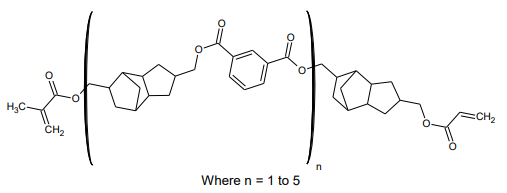PEAM-645 High Tg Polyester Acrylate/Methacrylate
- High Tg
- Low CTE
- High adhesion to various substrates
Product Description
PEAM-645 is a polyester acrylate/methacrylate that exhibits low CTE, high Tg, and high modulus. The oligomer has very high thermal stability and low volatility. It can be used as a base resin in a formulation or as an additive. It exhibits good adhesion on various substrates. The oligomer also exhibits good hydrolytic stability
PEAM-645 is recommended for use as a base resin in adhesive applications or coating applications. The material if used alone can exhibit brittleness and the incorporation of a toughener (such as ABS, or hyperbranched polyester) is recommended. The oligomer has good solubility in both aliphatic and aromatic co-monomers. PEAM-645 is more akin to epoxies with the smaller molecular weight (still big compared to most epoxies but much smaller than the PEAM-1044) and with higher Tg as a result. It common to mix these product for optimal results.
Technical Specifications
| General Properties | |||||||||
| Appearance Appearance Appearance at room temperature. | Amber Liquid | ||||||||
| Physical Properties | |||||||||
| Viscosity Viscosity Viscosity is a measurement of a fluid’s resistance to flow. Viscosity is commonly measured in centiPoise (cP). One cP is defined as the viscosity of water and all other viscosities are derived from this base. MPa is another common unit with a 1:1 conversion to cP. A product like honey would have a much higher viscosity -around 10,000 cPs- compared to water. As a result, honey would flow much slower out of a tipped glass than water would. The viscosity of a material can be decreased with an increase in temperature in order to better suit an application | 5,000 mPa.s | ||||||||
| Mechanical Properties | |||||||||
| |||||||||
| Thermal Properties | |||||||||
| |||||||||
| Glass Transition Temperature (Tg) Glass Transition Temperature (Tg) The glass transition temperature for organic adhesives is a temperature region where the polymers change from glassy and brittle to soft and rubbery. Increasing the temperature further continues the softening process as the viscosity drops too. Temperatures between the glass transition temperature and below the decomposition point of the adhesive are the best region for bonding. The glass-transition temperature Tg of a material characterizes the range of temperatures over which this glass transition occurs. | 160 °C | ||||||||



